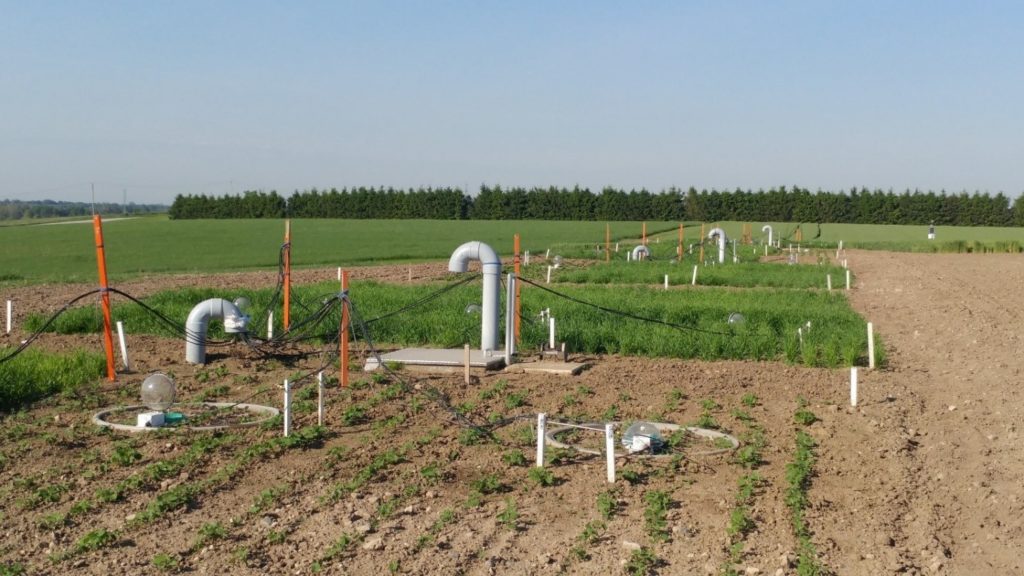Reem Zeitoun, Mark Vandergeest, Hiteshkumar Bhogilal Vasava, Pedro Vitor Ferrari Machado, Sean Jordan, Gary Parkin, Claudia Wagner-Riddle, and Asim Biswas. 2021. In-situ estimation of soil water retention curve in silt loam and loamy sand soils at different soil depths. Sensors. doi: 10.3390/s21020447
Study Summary by Reem Zeitoun and Cameron Ogilvie
key messages
- Combining soil water sensors can provide simple, affordable, real-time measurements of soil’s ability to hold water
- Soil texture strongly influences how much water is held by the soil and how tightly it is held
- Field soil water sensors need to be calibrated for airflow in soil to avoid overestimating soil water content
Plants can’t access all of the water that’s stored in the soil. Some water is held tightly in very small pores, some water freely drains through large pores, and some is held loosely by the soil so that it isn’t lost but plants can still use it. We can measure the total amount of water in the soil fairly easily, and this measurement is called soil water content. But the physical forces that control water availability in soil are more complex, and they are called soil water potential. By combining soil water content and soil water potential measurements, scientists can create a soil water retention curve (SWRC). A soil’s SWRC represents the amount of water available to plants given the physical forces that control water movement in soil. The SWRC can be useful for scheduling irrigation, or understanding how different soil management practices impact water availability to plants.
Traditionally, soil scientists estimated SWRC through long and complicated laboratory methods. Instead, in this study we combined data from commercial soil water content and soil water potential sensors to predict SWRC in the field. Using field sensors would also be superior to laboratory measurement by allowing for real-time measurement of water availability in soil. Our study ran for one month in October 2016 at two monitoring study sites at Elora, Ontario (silt loam soil) and Cambridge, Ontario (loamy sand soil). Precise and frequent measurement intervals allowed us to collect lots of data points for all evapotranspiration events (water evaporation from soil and water transpiration through plants) over the study period. We fitted the sensor data through popular SWRC computer models to predict further results.
WHAT THEY FOUND
Soil texture affects the SWRC strongly. Over the study period, silt loam soil had a greater average soil water content and lower soil water potential (0.29 m3m-3) than loamy sand (0.13 m3m-3) at the two soil depths tested (5 cm and 30 cm). The silt loam soil also had a lower average soil water potential (363.80 mbar) than loamy sand (2218.50 mbar). Together these measurement indicate that the smaller amount of water that remained in the loamy sand was held very tightly, but the larger amount of water in the silt loam was held more loosely. Because of the insulating effect of soil, the deeper soil layer (30 cm) of both soils showed more consistent soil water content throughout the evapotranspiration events. Unlike silt loam soils, loamy sand soils were more dynamic and had more variability in the SWRC fitted models.
We observed a strong correlation between the laboratory-measured data and the modeled data. Yet, the predicted water content of the field data overestimated the soil water content at different depths, with an average difference of -0.03 to 0.23 m3m-3 between the field data and laboratory data. This could be due to the air flowing in and out of the soil under real-time, dynamic conditions. This can affect sensor readings and can cause consistent variation between the dynamic field data and static laboratory data. It is recommended to calibrate the soil water sensors against air displacement in the soil to improve the sensors’ reliability. Still, consistent trends, with magnitude difference, indicated the potential to use these sensors in estimating SWRC and provided a way forward in overcoming time-consuming and complicated laboratory measurements.
WHY IT MATTERS
Our results demonstrated that soil sensor data can be used to accurately describe soil conditions in the field without needing resource-intensive laboratory measurement. Combining sensor data in the field can provide an affordable and easy way to create a real-time SWRC for precision water management and irrigation systems. But while using sensors is simple and cost-effective, there can be significant variability in some soil types. It is critical to calibrate soil water sensors for airflow through soil to improve reliability. The need for reliable tools in estimating dynamic real-time soil properties is a global issue and provides environmental benefits such as using water and energy more efficiently.
HOW THEY DID IT
This study was conducted for one month (October 2016) at two monitoring study sites at Elora, Ontario, and Cambridge, Ontario, and was published in January 2021. Two lysimeters were slowly pressed down in the soil using excavators and transferred to the monitoring sites (1 lysimeter per site). Dielectric principle-based water potential sensors (model MPS-6 from METER, USA) and time-domain reflectometry-based soil water content sensors (model TRIME PICO 32 from IMKO, Germany) were installed on the lysimeters at two depths (5 cm and 30 cm). The sensors’ data were collected at 10 minutes intervals. For each evapotranspiration event, sensors’ data were used to derive three parametric models (van Genuchten, Campbell, and Kosugi) to quantify real-time SWRCs. These were compared to laboratory-measured SWRCs, measured using conventional pressure plate methods from representative soil cores taken from the same depths as soil sensor placement.


